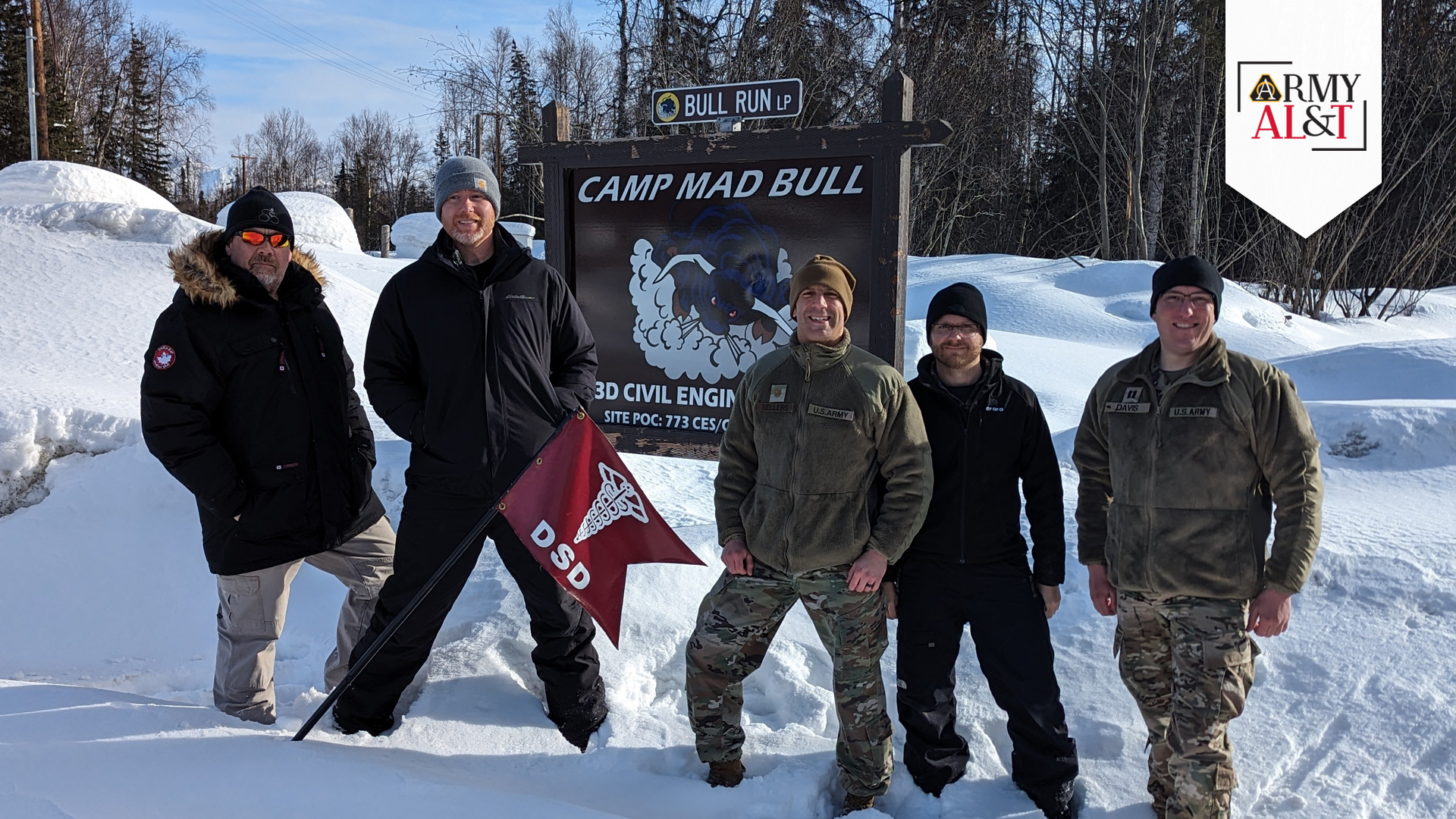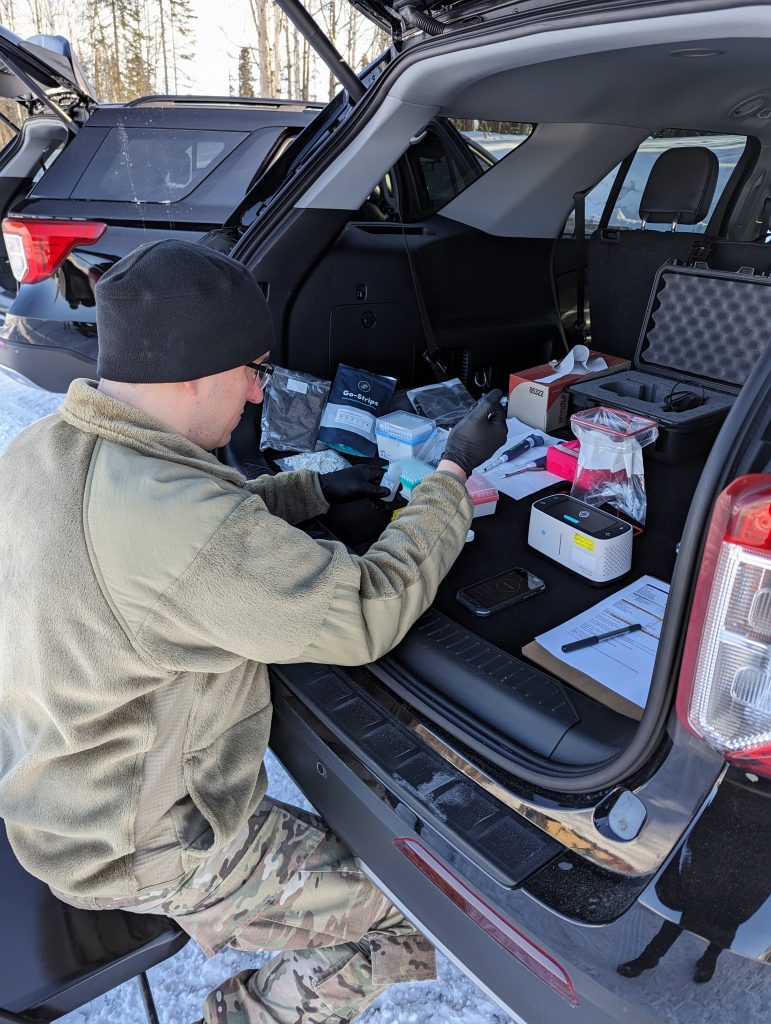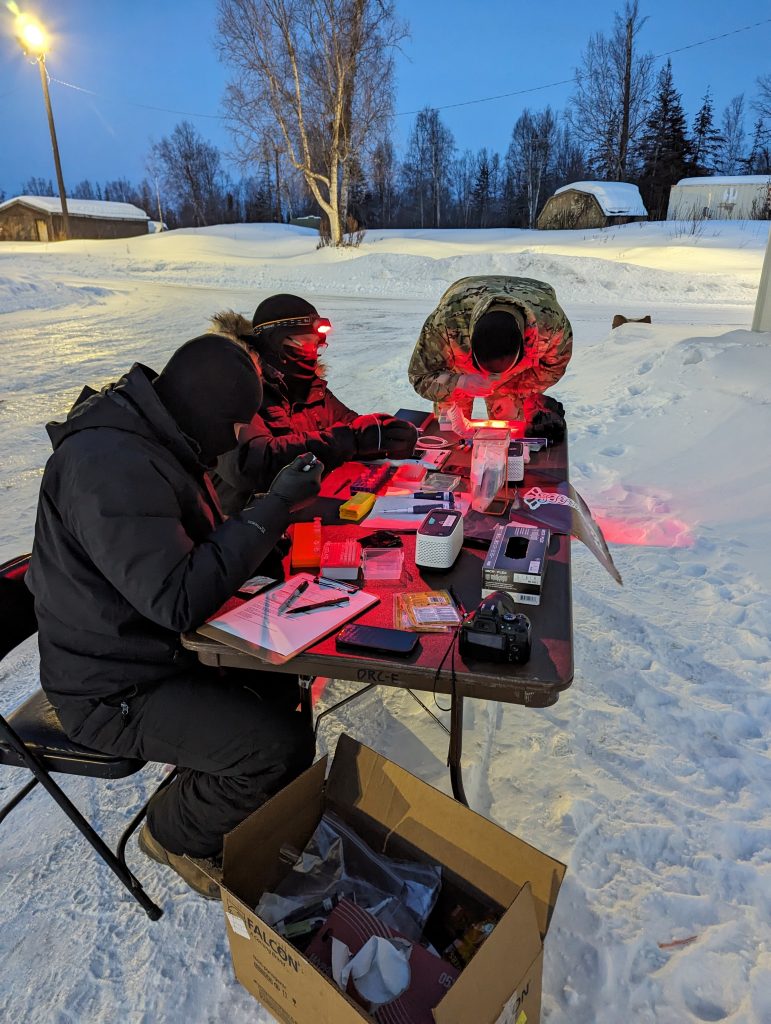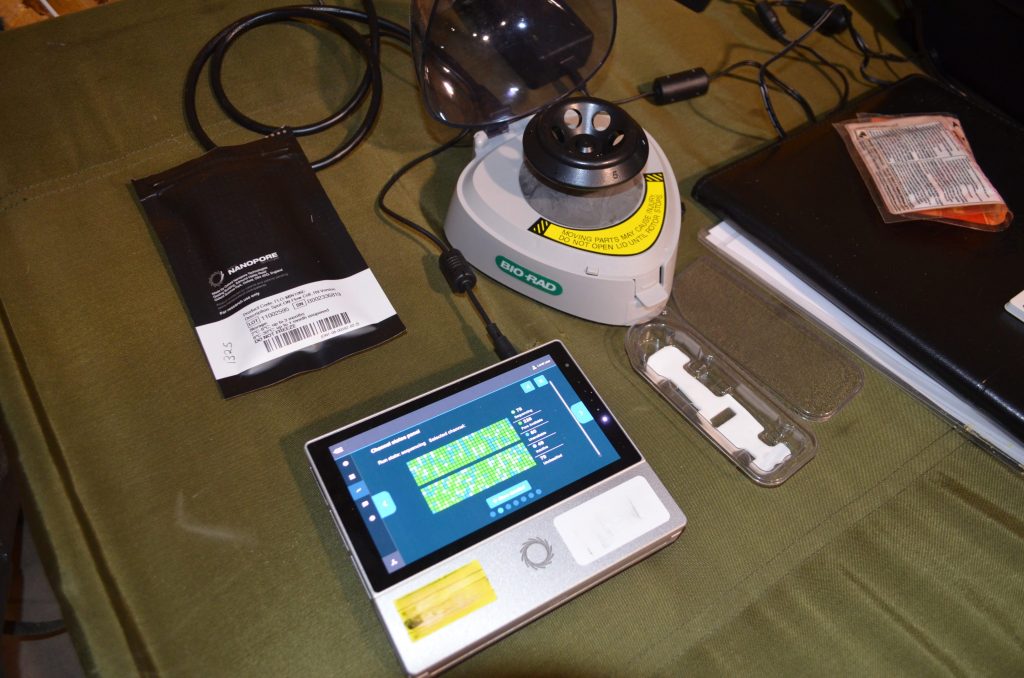
STRENGTH IN NUMBERS: From left: William Dorman, Paul Kallgren, Maj. John Sellers, Dr. Chris Stefan, and Capt. Ian Davis of the U.S. Army Medical Research Institute of Infectious Diseases Diagnostic Systems Division pose for a group photo on the final day of testing during Exercise Arctic Edge 2024 to commemorate a successful week of experimentation at Camp Mad Bull, Joint Base Elmendorf-Richardson, Alaska. (Photo courtesy of USAMRIID Public Affairs Office)
The Experimentation Integration Cell ensures that the right medical technology is at the right event at the right point in the acquisition process.
by Paul Lagasse
The mission of the U.S. Army Medical Research and Development Command (MRDC) is to create, develop, acquire and deliver medical capabilities to the warfighter. A critical part of ensuring mission success involves testing those capabilities in real-world conditions. Throughout the year, MRDC’s nine direct reporting units (DRUs) regularly participate in Army, joint service and multinational training exercises. They provide scientists and warfighters alike with hands-on opportunities to stress-test new capabilities and their protocols in a wide range of real-world conditions to ensure they are reliable and address gaps in providing far-forward care and returning warfighters to duty.
Two years ago, MRDC wanted to field multiple teams from across its DRUs to participate in Project Convergence (PC), a joint, multiyear and multinational experiment in the effective integration of modernization capabilities that is organized by the U.S. Army Futures Command (AFC), MRDC’s parent organization. But having each DRU coordinate individually with the experiment’s sponsor would risk confusion, inconsistency and redundancy for the DRUs and could also significantly increase the logistical, resourcing and administrative burden on the sponsors. So, Maj. Gen. Anthony L. McQueen, MRDC’s then-commanding general, charged the Office of the Principal Assistant for Acquisition—the organization responsible for fielding new and improved medical capabilities to end users after thorough testing and evaluation for use in austere combat environments—with creating an Experimentation Integration (EI) Cell to serve as a central coordination point for the command’s participation in persistent experimentation events.
The EI Cell has demonstrated success in reducing points of contact, streamlining the coordination process, integrating capabilities and improving the consistency and quality of information dissemination at PC 2022. As a result, it has become MRDC’s standard method for participating in readiness and interoperability exercises as a way to provide real-time testing of new medical technologies for the warfighter.

HAVE TRUNK, WILL TEST: Capt. Ian Davis of the U.S. Army Medical Research Institute of Infectious Diseases Diagnostic Systems Division conducts baseline testing in an extreme cold weather setting in the parking lot of Camp Mad Bull, Joint Base Elmendorf-Richardson, Alaska, during Exercise Arctic Edge 2024. (Photo courtesy of USAMRIID Public Affairs Office)
CELL STRUCTURE
“AFC has a directive for persistent experimentation,” said Col. John T. Nuckols, acting principal assistant for acquisition and the officer instructed by McQueen to stand up the EI Cell. “If you’re going to accomplish that, you have to create the environments and the relationships to conduct experimentation without interrupting training. Experimentation in training scenarios helps us not only gain perspectives on the limitations of our capabilities, but also to see how warfighters use the capabilities, often in unique and novel ways that we hadn’t even conceived. That’s very informative.”
The Office of the Principal Assistant for Acquisition (OPAA)—under the guidance of Nuckols, Acquisition Workforce Development Manager Eva Rosvold, and Science Advisor Joan Cmarik, Ph.D.—manages and coordinates MRDC participation in events sponsored by the capability development integration directorates, the Rapid Capabilities and Critical Technologies Office, program executive offices and similar organizations. A representative from the Office of the Principal Assistant for Research and Technology, OPAA’s counterpart on the research and development side of the organization, manages and coordinates MRDC’s participation in the AFC’s Future Studies Program and focused excursions.
To organize participation in these events, the EI Cell maintains relationships with the Futures and Concepts Center and the Medical Capability Development Integration Directorate. It also actively seeks opportunities to build relationships with new partners to facilitate participation in other events. This increased access significantly benefits MRDC scientists seeking venues to test and refine their new capabilities.

FREEZE FRAME: From left: Paul Kallgren, William Dorman, and Capt. Ian Davis of the U.S. Army Medical Research Institute of Infectious Diseases Diagnostic Systems Division conduct extreme cold weather testing on PCR and handheld assays before sunrise to achieve the coldest possible environment at Camp Mad Bull, Joint Base Elmendorf-Richardson, Alaska, during Exercise Arctic Edge 2024. (Photo courtesy of USAMRIID Public Affairs Office)
BENEFITS OF THE EI CELL APPROACH
The EI Cell has quickly found its niche as a joint interagency capability by enabling MRDC’s DRUs to “piggyback” on training exercises in ways that are both complementary and mutually beneficial to the experimenters and exercise sponsors and ultimately to the warfighter. By consolidating previously disparate efforts, serving as a single, consistent and reliable point of contact for medical experimenters and exercise sponsors and providing logistical support to experimentation teams before, during and after events, the EI Cell significantly improves the agility of MRDC to seize opportunities to participate in unique experimentation events that lead to more and better testing of new and improved medical capabilities.
“We define our role as making sure that we have the right products at the right type of events at the right time in their maturity or development,” says Rosvold. “This involves being a linchpin between the experimentation sponsors and DRUs. A lot of last-minute requirements and requests for information come up as an event progresses that can be complicated or confusing to understand. We help serve as a clearinghouse and help determine exactly what is needed from the DRU or sponsor.”
The EI Cell’s heterodox approach also embraces participation by industry partners in experimentation events alongside MRDC scientists and warfighters, providing a channel for MRDC to inform and influence industry best practices. “When we have innovative partners that come out into the field with us—and many times, they are veterans themselves—they find that things are very different from how they envisioned it in their labs,” said Nuckols. “I think that kind of experience is very informative to industry and in some cases, it may even help them be more competitive. The lessons learned and gathered at an event will help not only those who participated, but also ultimately the defense medical industry as a whole.”
ARCTIC EDGE 2024: A CASE STUDY IN COORDINATION
The EI Cell coordinated the efforts of four DRUs and a collaborating partner, the Naval Health Research Center, to test seven technologies at Arctic Edge 2024, the annual exercise led by the U.S. Northern Command at Joint Base Elmendorf-Richardson (JBER) in Alaska, in February and March 2024. Representatives of the Diagnostic Systems Division of the U.S. Army Medical Research Institute of Infectious Diseases (USAMRIID) tested three field-forward devices for detecting the presence of pathogens—a real-time polymerase chain reaction (PCR) thermocycler, a lateral flow immunoassay and a portable targeted genomic sequencer—in extreme cold-weather conditions. Their participation was part of the division’s efforts to get commercial off-the-shelf testing devices into the hands of service members who can stress-test them in the field under real-world conditions—to “kick the tires,” in the team’s parlance—so that they can be deployed more quickly than by going through traditional acquisition processes.
Cmarik worked with Maj. John Sellers, the USAMRIID team’s lead, and representatives from the U.S. Air Force to ensure they had the correct points of contact and other necessary information for delivering supplies, reagents and personnel to JBER. She also coordinated with the exercise organizers to ensure the team had the resources they needed when they arrived. The team arrived at JBER a week early since their experiments would not need to be operated by service members—that will happen in future tests—and Cmarik traveled to JBER to provide on-site assistance.
“Dr. Cmarik was very proactive in terms of making sure that I was getting the support I needed from the POCs that she put me in touch with,” said Sellers. “Once we got on ground, it was a very smooth process. The team was testing within probably an hour and a half of arriving at the testing site.”
The extreme cold and high winds of Alaska provided the USAMRIID team with valuable knowledge that they would not be able to gain in a lab setting, even inside their own cold-weather facility. The wind blew off pipette tips, scattered notes and reduced the dexterity of scientists’ hands clad only in nitrile gloves, while the extreme cold froze samples and reagents, turned plastic tools brittle and lowered battery efficiency, reducing the number of test runs that could be completed.
In identifying solutions for these problems, the scientists focused on using things that warfighters would likely have on hand in the field, such as chemical hand warmers, flameless ration heaters and, in a pinch, even body heat. They will use this experience to develop initial protocols that warfighters will test in subsequent exercises and to suggest novel solutions, such as 3D-printed immunoassay holders with slots for inserting hand warmers to keep them from freezing.
“That’s the reason we took this team to Arctic Edge,” said Sellers. “Our reason for going was to break this stuff, but I knew they had the expertise to address and solve these problems on the fly. A medic or a warfighter trying to perform tests following strict protocols might find it very difficult under those conditions.”
With support from the EI Cell, the Diagnostic Systems Division plans to participate in next year’s Arctic Edge to conduct baseline testing on another group of technologies, to be followed by additional cold-weather testing during which warfighters will get a chance to use the diagnostic tools in training scenarios, following the protocols developed by the USAMRIID team based on their Arctic Edge experience.

MINION TESTING: The Oxford Nanopore Technologies MinION Mk1C Sequencer undergoes indoor testing by researchers from the U.S. Army Medical Research Institute of Infectious Diseases Diagnostic Systems Division at Camp Mad Bull, Joint Base Elmendorf-Richardson, Alaska, during Exercise Arctic Edge 2024. (Photo courtesy of USAMRIID Public Affairs Office)
CONCLUSION
In just a short time, MRDC’s EI Cell has made it easier for the organization’s DRUs to field-test a wide range of impactful, life-saving medical capabilities, including pathogen diagnostics, casualty collection and protection, temperature sensors and hypothermia prevention, freeze-dried plasma and oxygen generators. As the command’s central coordinator for participation in experimentation events, the EI Cell eliminates pain points that would otherwise prevent participants from getting the most out of their time in the field.
Furthermore, because much of the experimentation conducted at MRDC is iterative, research teams may want to return to annual and semi-annual exercises in subsequent years, particularly when a capability has matured to the point where it is ready to be handed off to warfighters to see how they train with it and incorporate it into their routine operations. The ability of the EI Cell to build lasting relationships with event sponsors gives DRUs confidence that their experimentation teams will have the information they need to plan and execute those experiments successfully.
The leaders of the EI Cell believe their approach to integration could represent a model for other military services and government research organizations to improve their agility in developing, testing and fielding new capabilities.
“What started as a way to coordinate the DRUs has evolved into a joint and interagency capability that acts like glue or mortar holding the process together,” said Nuckols. “You need to have cool minds at the table who understand that failure is acceptable. It’s the nature of experimentation that things will change; you have to be able to capture value in the change. How we overcome that failure and how we learn from it is what the EI Cell does very well. We’re not going in with a firm vision of what will happen; we’re going in with an agile vision of what can happen and how to take advantage of that to get better results.”
For more information, go to https://mrdc.health.mil.
PAUL LAGASSE is a public affairs writer with USAMRDC. He has an M.A. in history and an M.L.S. in archival studies from the University of Maryland, College Park and a B.A. in history from Regis University, Denver. Before working in public affairs for the Army and Navy, he was a newspaper reporter and a freelance writer and editor.







